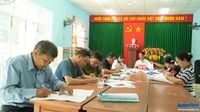On April 20, 2025, Quang Ngai province witnessed a significant democratic engagement as voters actively participated in the collection of opinions regarding the proposed administrative reforms aimed at merging Quang Ngai and Kon Tum provinces. This initiative is part of a broader strategy to streamline administrative units at the commune level, reflecting a decisive move by the government to enhance efficiency and governance.
In a remarkable turnout, over 98% of voters expressed their support for the two proposed projects, showcasing a strong public consensus on the need for administrative reform. The city of Quang Ngai organized 139 groups across various villages and residential areas, facilitating the participation of over 71,000 voters, who represented their households in this critical decision-making process.
The reforms are designed to establish three new wards—Duc Pho, Tra Cau, and Sa Huynh—and two communes, Nguyen Nghiem and Khanh Cuong, by merging existing administrative units. This restructuring is expected to simplify governance and improve service delivery to the citizens, aligning with the government's goal of creating a more efficient administrative framework.
In the neighboring district of Binh Son, more than 54,000 voters also participated in the opinion-gathering process regarding the administrative arrangements. The overwhelming majority of voters supported the proposed changes, indicating a widespread recognition of the necessity for reform in local governance.
Meanwhile, Tu Nghia district reported an impressive 99.76% agreement among voters to merge Quang Ngai and Kon Tum provinces under the name of Quang Ngai. Additionally, 99% of voters endorsed the arrangement of 13 existing communes and towns into four new communes, further emphasizing the public's commitment to the reform agenda.
In Mo Duc district, plans are underway to create four new communes—Mo Duc 1, Mo Duc 2, Duc Tan, and Mo Duc 3—through the consolidation of several existing administrative units. This initiative is part of the broader objective to streamline the administrative structure and enhance governance across the province.
Son Tinh district also engaged in the democratic process, organizing 58 meetings to collect voters' opinions. The participation rate was notable, with 94.7% of residents casting their votes. Among these, an overwhelming 99.8% supported the merger of Kon Tum province into Quang Ngai, while 96.82% agreed with the proposed changes to commune-level administrative units.
In Nghia Hanh district, citizens expressed enthusiasm for the administrative reforms, with many attending meetings to voice their opinions on the restructuring of provincial-level units and the naming of communes post-reform. The active participation of the community underscores a collective desire for improvement in local governance.
In Ba To district, over 17,500 voters participated in the opinion collection process, demonstrating their commitment to civic engagement and the democratic process. The residents gathered at 93 cultural houses to express their views on the proposed administrative changes, highlighting the importance of community involvement in shaping local governance.
Minh Long district, which encompasses five communes and 30 villages, is set to establish two new communes as part of the 2025 administrative plan. This restructuring aims to enhance the efficiency of local governance and ensure that administrative services are more accessible to the public.
In the district of Tra Bong, residents eagerly participated in voting on the merger of provincial-level administrative units and the arrangement of commune-level units. The turnout was high, with citizens prioritizing their participation in this important civic duty, reflecting a strong commitment to the future of their governance.
Residents of Son Ha district also gathered to vote on the proposed administrative arrangements, showcasing a collective enthusiasm for the reforms. The participation of citizens in these discussions is crucial for ensuring that the reforms align with the needs and expectations of the community.
Soon after the voting commenced, it became evident that the public was largely in favor of the proposed changes. Many expressed optimism that the restructuring would lead to a more effective administrative system, ultimately benefiting the local population.
In Son Tay district, the community gathered at cultural houses to discuss and vote on the proposed administrative reforms. The overwhelming consensus among residents indicated a shared belief in the necessity of these changes to improve governance and service delivery.
In Lý Sơn district, six meetings were held to collect voters' opinions on the merger of the province and the renaming of Lý Sơn Special Zone. The results were overwhelmingly positive, with 99.92% of voters agreeing to merge Quang Ngai and Kon Tum provinces, and 99.4% supporting the transformation of Lý Sơn district into a commune-level administrative unit.
The organized approach to collecting opinions reflects a commitment to transparency and public participation in governance. The government’s efforts to engage citizens in the decision-making process are crucial for fostering trust and ensuring that the reforms meet the needs of the community.
As Vietnam continues to evolve, the push for administrative reform in Quang Ngai province serves as a pivotal moment in the country's governance. The successful implementation of these changes is expected to enhance the efficiency of the administrative apparatus, ultimately leading to improved public services and a stronger connection between the government and its citizens.
With a clear mandate from the public, local authorities are poised to move forward with the proposed administrative reforms, paving the way for a more streamlined and effective governance model that prioritizes the needs of the people.





